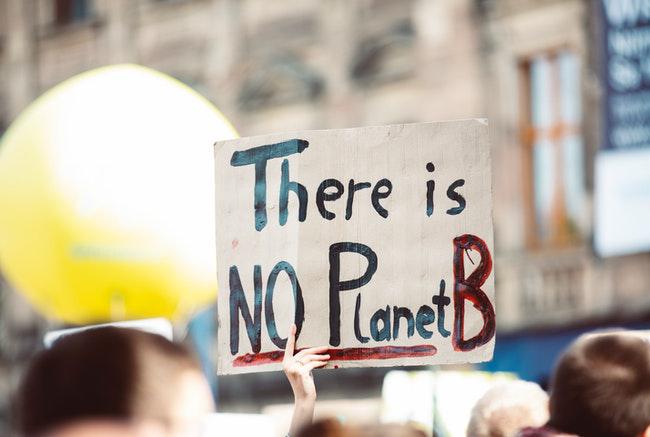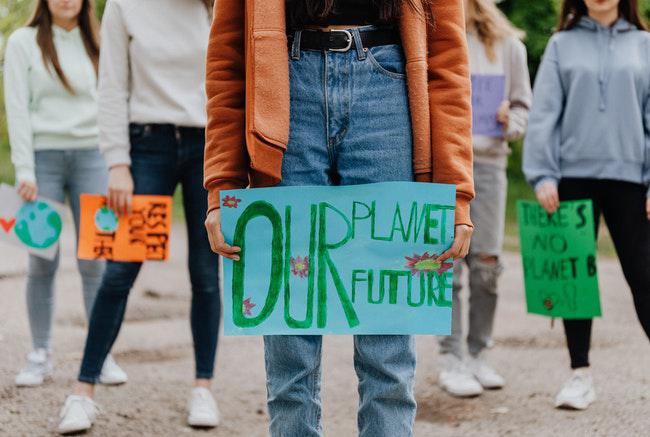Categories
What is eco-anxiety? Our step-by-step guide
8 minute read

In last week’s blog post, Serena Lee Chau shared her experience on coming to terms with eco-anxiety. Which is the overwhelming sensation you might experience when you think too much about the state of the planet. In the blog, Serena revealed her manifesto to help her live a green, guilt-free lifestyle, which helped her to overcome her eco-anxiety.
This week’s blog looks a little closer into what eco-anxiety is and offers some tips that could help you live more sustainably, without the added stress.
It’s completely natural to feel a small sense of fear when thinking about climate change. Not only is it a huge and scary topic, but it can feel impossible to escape. Does this sensation sound familiar? If so, you could be feeling the effects of eco-anxiety. But don’t worry, you’re not alone and there are ways to cope and even overcome it.
It’s easy to understand why this might be happening to so many of people. The climate conversation is all around us: in the weather forecasts, on the nightly news, and even on the adverts from our favourite brands.
In this blog, we want to change the conversation. To start looking about ways we can overcome eco-anxiety, and move toward a greener, calmer way of thinking. Hopefully, with some small, but meaningful, changes you can feel empowered to make a real difference, both for your mental wellbeing and the world around you.
What is eco-anxiety?

Very simply, eco-anxiety is a feeling of worry, fear or depression associated with thoughts about environmental issues.
Speaking to giffgaff, Flora Bannerman, Partnerships Manager at Mental Health UK, explains it better:
“Feeling worried or anxious some of the time is a natural human response to certain situations when we feel that we are under threat. However, when feelings of anxiety impact our ability to go about our day-to-day lives and are very strong or long-lasting, it can be a sign of an anxiety disorder.
“The climate crisis can definitely have this effect, especially when it dominates headlines and our daily conversations. But the good news is there are ways to manage and even overcome it–through self-care strategies as well as through your GP, talking therapies and other services.”
How do I know if I have eco-anxiety?
The symptoms of eco-anxiety are very similar to other forms of anxiety. Feeling nervous or tense, having an impending sense of doom you can’t shake, increased heart rate, sweating, and feeling weak or tired are all common symptoms.
But the things that puts the ‘eco’ in eco-anxiety, is that your symptoms worsen when you think about things like this:
- Our over-reliance on fossil fuels and the immense waste these fuels produce
- The impact of the meat industry on the production of greenhouse gases
- The amount of plastics we produce, and how many wind up in the ocean
- The loss of natural habitats, natural resources and the extinction of whole species in the pursuit of building factories, mines, roads and more
- And other issues relating to climate change and the environment
Feelings of eco-anxiety can also become worse the more someone feels culpable for taking part in these things. The more meat you eat? The more eco-anxiety you might feel.
So, what can we do to help relieve our sense of eco-anxiety?
Ways to overcome eco-anxiety
Eco-anxiety can make you feel like there’s no way out. But there can be. It’s time to come up with a plan.
1. Make a list of things that cause you eco-anxiety

| Cause of anxiety | Reason why you might feel anxious |
|---|---|
| Taking too many trips in your petrol-powered car. | You know your car causes pollution. |
| Eating too much meat or (unsustainable) seafood. | The meat industry is known to be a big cause of carbon emissions across the globe. |
| Being too reliant on products that come in plastic packaging or bottles. | Plastic packaging can be hard to recycle (especially if it has food waste or chemicals on it) and it’s very damaging to the environment. |
| Purchasing items that contain harmful chemicals or microplastics. | Chemicals and microplastics are damaging to the environment and food sources. And it’s very difficult to recycle microplastics and packaging that’s come into contact with harmful chemicals. |
| Making a lot of ‘little mistakes,’ such as leaving the tap on when you brush your teeth. Leaving the lights on when you’re not in. Or leaving your phone plugged into a charger even after it’s reached 100%. | You know they are small, but you also know they are wasteful. And small things add up over time. |
By writing down the causes and reasons for your eco-anxiety, it can help you to understand why you might be getting anxiety, what the problems are for you specifically, and what you can do to make positive changes in the future.
2. Make a list of things you can change

Now, next to each one, write a simple, straight-forward change that you can make in your everyday life. And a positive reason for the change. For example:
| Change you can make | Why it’s positive |
|---|---|
| Buy a used bike and start cycling more often. | You’ll get fit while helping the environment by reducing your personal carbon emissions. |
| Try to eat one more vegetarian or vegan alternative every day, or consider going meat-free altogether. | Reducing meat consumption is known to help reduce carbon emissions. And for some people it can be a healthier option. |
| Shop more at outdoor markets, and bring a fabric bag with you when you go shopping. | Outdoor markets usually have locally sourced produce. Meaning that less emissions are used in transporting food. Plus, you’ll get the health benefit of shopping in the fresh air. |
| Find alternatives to plastic, perhaps by shopping in plastic-free or zero-waste stores. | It’s simple, by buying products that aren’t wrapped in plastic means that you’re reducing plastic waste. Less hassle for your recycling bin and better for the environment. |
| Shop for natural products. Items that don’t contain harmful chemicals or microplastics. | You’ll be reducing the potentially damaging waste that comes from these products. |
| Try to get into the habit of checking if lights are off when you leave a room. The more you do this, the more natural it will feel. | You’ll be reducing unnecessary waste and energy consumption. Meaning you’ll be helping the environment and your wallet. Win-win. |
By writing down a change that you can make in your everyday habits, can help you to understand how easy it can be to stop or (at least) combat the things that cause you eco-anxiety.
And writing down the positive reason for the change can help you understand why a good change for the environment, and also why it’s a positive change for you personally. Some of these changes can be good for your health or even help save you money in the long run.
Often it’s about making small changes to your daily habits. Getting into good habits will help to make these changes easier and feel more natural.And it should help reduce that feeling of eco-anxiety..
3. Remember, there’s no quick-fix to eco-anxiety

It’s also important to remember that no-one can be completely eco-conscious all the time. This is one of the mantras that Serena Lee Chau mentioned in last week’s blog.
So, if you do slip or struggle to make a natural change, go easy on yourself. And take comfort in knowing that every tiny change you make really is having an impact.
4. Help your friends
Once you’ve made some positive changes in your own life you can try to help other people be more eco-conscious too.
One of the best ways to do this is to look to your friends and family. Could some of the small changes you’ve made help them as well? If so, help guide them to follow in your footsteps.
Here are some easy ways to get your friends and family involved in your eco-mission:
- Plan a group holiday close to home, based around a sustainable pursuit like mountain biking
- Host a meat-free and/or plastic-free dinner party, so they can experience how simple (and tasty) it can be to live sustainably
- Buy eco-friendly gifts for your friends and family, to help introduce them to sustainable products they might not pick up for themselves
5. Spread the word far and wide
If you feel compelled to spread the word further, that’s great. Thanks to the power of the Internet, you could persuade hundreds or even millions of people to follow in your footsteps. Start a blog. Make a video. Build a social media persona.
Show people your journey to overcoming eco-anxiety and offer advice to help others change their lifestyle.
You could even share some of the ideas and resources from the Mental Health UK website, like their piece on climate anxiety.
As Flora reminds us:
“When it comes to eco-anxiety, we can all be there for one another and empower each other to learn about what we can do to look after our planet, and our mental health.”
Looking for some extra support?
Our friendly giffgaff community are always happy to support fellow members-in-need. If you’re feeling anxious, try reaching out on the mental health support thread. If nothing else, it’s always comforting to feel that you’re not alone.





